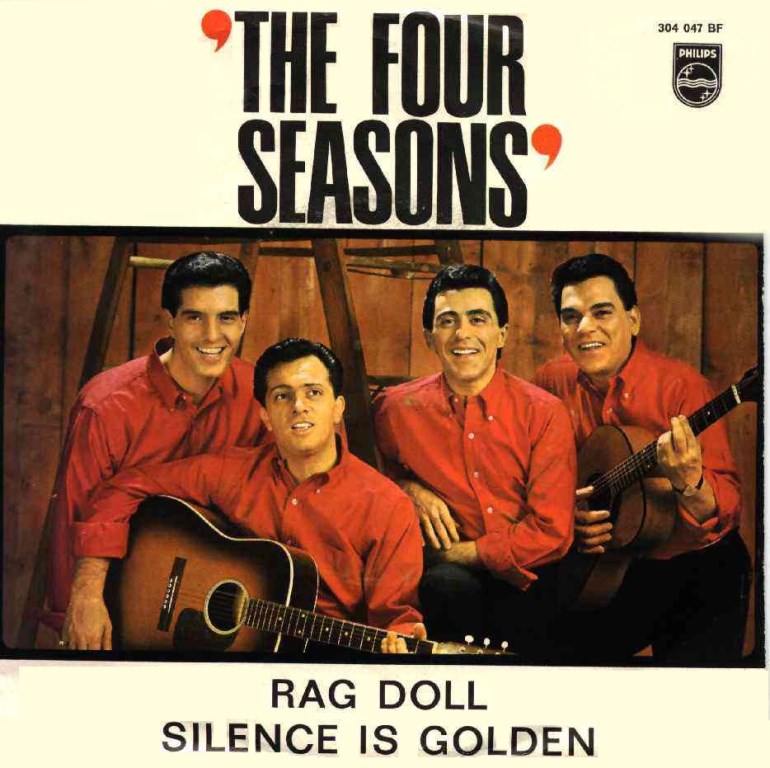In The Number Ones, I'm reviewing every single #1 single in the history of the Billboard Hot 100, starting with the chart's beginning, in 1958, and working my way up into the present.
The Four Seasons - "Rag Doll"
HIT #1: July 18, 1964
STAYED AT #1: 2 weeks
There will never be an edition of this column devoted to the Ronettes' "Be My Baby." There will never be an edition of this column devoted to the Ronettes at all. The most iconic of all the early-'60s girl groups -- excepting the Supremes, who are in their own category -- never charted higher than #2. That's where "Be My Baby" landed late in 1963. And yet that song has been inscribed on pop music's DNA. Phil Spector's opening drum beat from "Be My Baby" -- boom boomboom crack! -- is a perfect moment that has echoed through history. It's been borrowed over and over, from the Jesus And Mary Chain's "Just Like Honey" to Poison's "Cry Tough" to Bat For Lashes' "What's A Girl To Do?"
I'm not enough of a music historian to know who the first group to borrow that "Be My Baby" intro was, but it may very well have been Frankie Valli's Four Seasons, whose "Rag Doll" came out 10 months after "Be My Baby." The opening of "Rag Doll" isn't exactly the same as that of "Be My Baby"; the snare doesn't come in until after the vocals. But it's a pretty clear sign that the American groups who were getting to #1 in that early Beatles era weren't necessarily chasing the Beatles. They were chasing Phil Spector, who was revolutionizing pop music in ways that had nothing to do with the Beatles, his own future Let It Be collaborators.
The Four Seasons' version of the Phil Spector sound worked wonders for the group. The early Four Seasons hits were based entirely around the party trick of Valli's strangled-balls falsetto, a sound that I will always find deeply vexing. But magical things happened when the group started recording music with thicker, lusher textures. First, there was "Walk Like A Man," where the group discovered a newfound propulsion and swagger. And then there's "Rag Doll," a pop-music symphony that's easily my favorite Four Seasons hit.
Lyrically, "Rag Doll" is about as simple as it gets. Bob Gaudio, the Four Seasons member who co-wrote the song, has said that it was inspired by a little girl in tattered clothes who ran up to scrub his car at a stoplight and about the look of astonishment that she gave him when he handed her a five-dollar bill. And so the song is about a poor girl, sung from the perspective of the boy who loves her but who's too cowardly to do anything about it: "I'd change her sad rags into glad rags if I could / My folks won't let me cuz they say that she's no good." There's no happy ending; apparently, the guy just accepts his parents' class discrimination and moves on.
But the point of the song isn't the lyrics. It's that gorgeous arrangement, which deploys Valli's falsetto sparingly, and to great effect. The Four Seasons' voices pile up in layers, doing things that go beyond doo-wop and into some blissed-out dream-state. Tambourines and chimes and tremolo guitar, all slathered in echo, reverberate throughout the mix. It's a perfect little pop-music creation and a sign of the ridiculously quick advances in studio-pop technique at the moment. Pretty soon, a whole lot more pop music would sound something like this.
GRADE: 9/10
BONUS BEATS: Here's former Dexy's Midnight Runners frontman Kevin Rowland's eight-and-a-half-minute version of "Rag Doll," from his slightly notorious 1999 solo album My Beauty:






